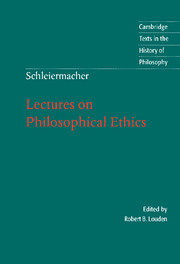Book contents
- Frontmatter
- Contents
- Introduction
- Chronology
- Further reading
- Note on the text
- Translator's note
- Lectures on Philosophical Ethics
- Ethics 1812/13: Introduction and doctrine of goods
- Ethics 1812/13: Doctrine of virtue and doctrine of duties
- Introduction, final version (probably 1816/17)
- Doctrine of goods, final version (probably 1816/17)
- Doctrine of duties, final version (probably 1814/17)
- Index
Ethics 1812/13: Introduction and doctrine of goods
Published online by Cambridge University Press: 05 June 2012
- Frontmatter
- Contents
- Introduction
- Chronology
- Further reading
- Note on the text
- Translator's note
- Lectures on Philosophical Ethics
- Ethics 1812/13: Introduction and doctrine of goods
- Ethics 1812/13: Doctrine of virtue and doctrine of duties
- Introduction, final version (probably 1816/17)
- Doctrine of goods, final version (probably 1816/17)
- Doctrine of duties, final version (probably 1814/17)
- Index
Summary
Introduction
Transition from critique to real depiction
1 The communication of a single distinct science cannot have any proper starting-point.
2 The individual science cannot have at its head a proposition which is immediately certain.
3 Even when deducing it from a higher science it can only be understood in conjunction with other knowledge which stands in opposition to it.
4 The establishment of this opposition can appear only as opinion.
5 Every science has a number of shapes. The very act of beginning creates a basis for one such shape, and yet it contains knowledge only inasmuch as it is comprehended historically in conjunction with the others. The history of the sciences cannot exist without the sciences themselves, however, which gives rise to a circularity.
6 We already know something of every science by virtue of common life and common critique.
7 This influence cannot be to the good where ethics is concerned, because of the unfavorable phenomenon whereby a number of approaches start from very different assumptions but end with the same results, thus [suggesting] either error or scientific inconsistency.
8 Eudaemonistic ethics are hypothetical in the individual instance, because a purpose can be achieved in various ways, which in reality are in opposition to one another, while only one of them may be chosen. At most, therefore, they are an exposition of inclination: in the individual instance on technical grounds, and as a whole, because choice is based on inclination.
9 The Kantian form of rational ethics posits guiding thoughts to any action and can therefore only correct or perfect; it cannot, even were one to submit to it entirely, construct out of nothing.
- Type
- Chapter
- Information
- Schleiermacher: Lectures on Philosophical Ethics , pp. 3 - 99Publisher: Cambridge University PressPrint publication year: 2002



